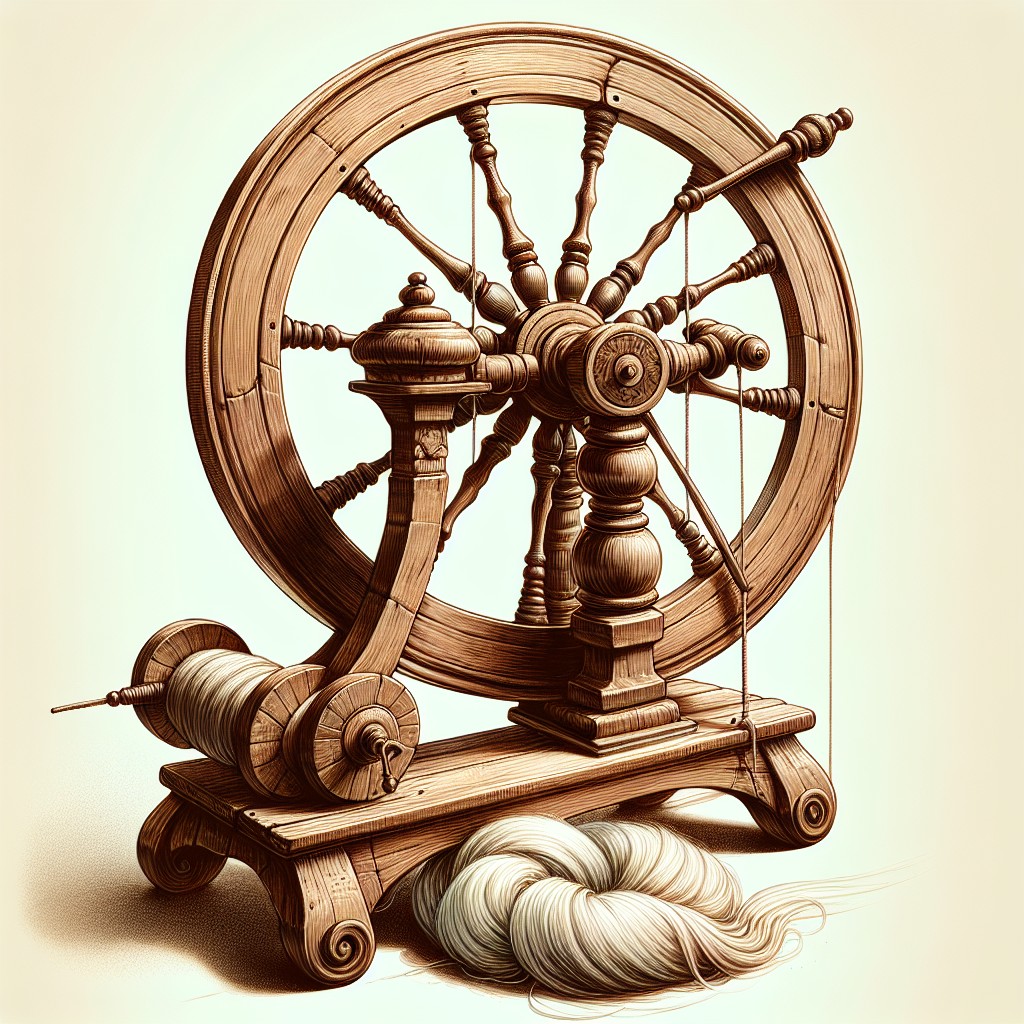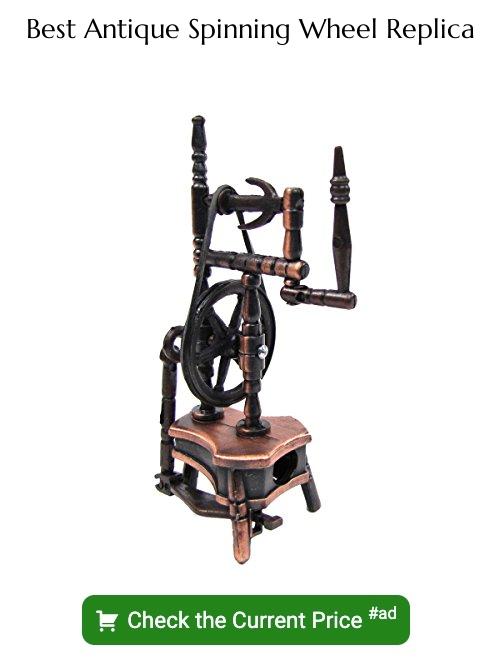Embarking on the quest to identify an antique spinning wheel may feel daunting, but this comprehensive guide simplifies the process because it provides accurate cues and characteristics that distinguish one spinning wheel model from another.
Key takeaways:
- Antique spinning wheels come in various styles with unique characteristics.
- The construction materials and techniques used can aid in identification.
- Manufacturer’s marks and signatures provide valuable information about origin.
- Regional design variations reflect local materials and cultural aesthetics.
- Style elements, treadles, and foot power mechanisms correlate with historical time periods.
Types of Antique Spinning Wheels

Antique spinning wheels come in various styles, each with unique characteristics. The Saxony wheel, renowned for its horizontal orientation and large, decorative wheel, is a common find. It traditionally features intricate carvings and a single treadle that operates the wheel via a foot pedal.
The Castle wheel, on the other hand, is more compact, with a vertical wheel arrangement that conserves space. Its footprint is smaller, thus making it a more practical choice for spinners with limited room.
The Great Wheel, also known as the Walking Wheel, is notable for its size and the fact that it is operated by hand-spinning the wheel, rather than using a treadle. Its large, unmistakable presence often draws the eye in antique collections.
Norwegian wheels are distinguishable by their beautiful craftsmanship and often include a secondary table for bobbin storage. They’re admired for distinct slanted mother-of-all, and often, maidens with stylized shaping.
The double-flyer wheel is a less common antique, which possesses two spindles allowing for the simultaneous spinning of two threads.
Each of these wheels has nuances in design, structure, and operation. Recognizing these will assist in accurate identification and appreciation of their place in textile history.
Distinctive Features of Saxony Wheels, Castle Wheel Variants

Saxony wheels, with their horizontal orientation, are a classic silhouette recognizable by the large wheel on one side and the flyer on the opposite end. Characterized by their gracefully sloping table-like frames, they often have detailed turnings and decorations, especially if they hail from the 18th or 19th century.
In contrast, castle wheels boast a more compact, vertical design, making them ideal for small spaces. The flyer and wheel align vertically, with the mother-of-all sitting directly above the wheel. Often, these wheels have a more modest appearance, but some may feature ornate carvings or paint.
To distinguish between the two, pay attention to the wheel’s position in relation to the flyer and the overall structure. A Saxony wheel has a spread-out layout with the flyer at one end, while a castle wheel’s components are stacked, indicating efficient use of vertical space. Keep an eye out for the drive wheel’s size; larger wheels typically signal a Saxony wheel, with smaller, more contained wheels usually indicating a castle variant.
Construction Materials and Techniques

Understanding the construction materials and techniques used in antique spinning wheels can greatly aid in their identification. Many vintage wheels are crafted from common woods such as maple, walnut, oak, and pine, with hardwoods often indicating a higher quality piece. Look for signs of handcrafting, such as tool marks or irregularities in the wood that suggest it was shaped by an artisan rather than mass-produced machinery.
Joints and connections might feature mortise and tenon construction, a hallmark of pre-industrial craftsmanship. Examine any metal components for forging marks, which may be present on earlier wheels, while later models might have machine-cut parts.
The finish on an antique wheel can also provide clues; original finishes from past eras range from natural oil and wax to shellac and varnish. Check for wear patterns and oxidation on metal parts, which can tell you about the wheel’s age and use.
In addition, spinning wheel makers often employed specific techniques that can hint at the provenance of the wheel. For example, Shaker wheels are known for their simplicity and fine craftsmanship, while great wheels or walking wheels typically display a more rustic and utilitarian construction.
By becoming familiar with these elements, you enhance your ability to accurately identify the origins and age of an antique spinning wheel.
Identifying Manufacturer’s Marks and Signatures

Many antique spinning wheels carry distinctive marks or signatures that can provide valuable information about their origin. These identifiers are often found on the wheel’s bench, flyer, or table. To unearth these clues:
1. Inspect the underside of the spinning wheel, including any drawers or hidden areas for stamps, carvings, or labels.
2. Examine the head of the wheel or the spokes for any incised initials or symbols.
3. For wheels with paint or decorative elements, look for signatures within the artwork, as craftsmen sometimes incorporated their mark into the design.
4. Consider using a soft light source at an angle to highlight faint markings that could be easily overlooked.
5. Research the found marks in databases or reference guides dedicated to antique spinning wheels as they can link your wheel to a specific maker or region.
6. Consult with experts or collectors’ groups online to aid in the identification process if you encounter unfamiliar or hard-to-decipher marks.
By following these steps, you can often piece together the heritage of an antique spinning wheel and get a glimpse into its past.
Regional Design Variations
As you explore antique spinning wheels, the influence of regional craftsmanship becomes evident. Each area had its unique approach to wheel design, often reflecting local materials and cultural aesthetics. For instance, the Great Wheel, also known as the Walking Wheel, primarily found in colonial America, exhibits a large wheel and a simpler construction, representing the utilitarian mindset of early settlers.
In contrast, European wheels, like the intricately detailed Norwegian wheels, showcase elaborate carvings and painted decorations, pointing to a tradition of artistry and display.
Moving to the British Isles, the presence of Irish Castle wheels with their compact, vertical design suggests space-saving considerations in smaller homes. Meanwhile, the flax wheels of Belgium and Holland, designed for the fine spinning of flax fibers, indicate the textile demands of these regions.
Even the function and form of the flyer assembly—essential for twisting the fiber into yarn—vary, with double-drive flyers in some English models and Scandinavian wheels often featuring a single-drive with a fascinating bobbin-led mechanism.
Understanding these variations helps to not only trace the spinning wheel’s origin but also provides insight into the cultural and practical needs of the past societies they served.
Historical Time Period and Style Correlation
Correlating a spinning wheel to its historical era is often a matter of examining style elements and construction methods. During the 17th and 18th centuries, wheels typically featured ornate carvings and were made of dense, sturdy woods. The Great Wheel or Walking Wheel, for example, was common until the late 18th century.
As you venture into the 19th century, the influence of the Industrial Revolution becomes apparent. Spinning wheels from this period show a transition to more utilitarian design, often with lighter woods and less decoration. The introduction of the treadle in the early 19th century created a functional change as well, moving from hand-powered to foot-powered spinning.
Understanding the evolution of styles can also link a wheel to a particular time frame. For instance, the Saxony wheel with its classic, horizontal orientation became popular in Europe, while the smaller, vertical Castle wheel is a later variant that saved space.
Look for certain key elements to guide your assessment:
- Complexity of the wheel’s design, with simpler lines suggesting a later manufacturing date.
- Type of wood used, as advances in transport and trade introduced new materials over time.
- The functionality of the wheel, considering whether it reflects household practicality or industrial efficiency.
By gauging these elements, you can narrow down the era during which a wheel was likely produced.
Presence of Treadles and Foot Power Mechanisms
Exploring the lower assembly of an antique spinning wheel can provide insight into its age and style. Most notably, the presence and design of treadles, which are foot-operated levers, often reveal the progression from earlier, more manual spinning practices to later, treadle-driven mechanisms.
1. Single vs. Double Treadles: Single treadles date back farther and require both feet to operate one pedal, while double treadles allow for an alternating foot motion and are indicative of more modern designs.
2. Treadle Shapes: The shape of treadles can vary from simple, flat boards to more intricate designs with carved patterns, indicative of the level of craftsmanship and the era of production.
3. Drive Wheel Linkage: Examining how the treadles are connected to the drive wheel helps identify the wheel’s action type. A direct connection suggests a single-drive wheel, whereas an indirect link via additional parts suggests a double or Scotch tension drive mechanism.
4. Wear Patterns: Foot-powered wheels often exhibit wear on the treadles, which can confirm their use and highlight the wheel’s authenticity. Uneven wear might suggest historical domestic usage.
By analyzing these components, enthusiasts can better understand the functionality and evolution of antique spinning wheels, adding depth to their identification.
Condition and Patina As Age Indicators
When examining an antique spinning wheel, the item’s condition and patina can provide clues to its age. A genuine patina reflects a gentle wear and a rich, deepening of color that develops over time on wood and metal surfaces. This natural aging process is difficult to replicate authentically, making it a valuable indicator.
Look for areas where hands and feet have frequently touched; these spots often show smoother surfaces and a naturally darkened wood, suggesting years of use. Also, consider the presence of wear-and-tear, such as minor scratches, dents, or worn paint in areas of high contact, like the spindle or treadles.
Examine the hardware, such as screws and bolts. Antique spinning wheels will typically have hardware that is less uniform and shows signs of blacksmithing or hand forging, with potential rust or patination that align with the wheel’s overall aging.
While assessing, be mindful that some antique spinning wheels may have been well-maintained or restored, which could make the patina seem less prominent. However, restorations done with historical accuracy should not significantly alter the wheel’s venerable character. Always check for signs of recent varnishes or stains used to “antique” newer reproductions, which tend to gloss over rather than penetrate the wood.
Identifying Common Reproductions and Fakes
When sifting through potential antique spinning wheels, it’s crucial to discern authentic pieces from modern reproductions or fakes. Here are some indicators to help you make the distinction:
1. Wood Patina: Genuine antiques often have a deep, rich patina that has developed over time, while newer models may appear too pristine or have finishes that look artificially aged.
2. Construction Quality: Antique wheels typically showcase handcrafted imperfections, such as irregularities in the wood or asymmetry. In contrast, reproductions might have uniform, machine-cut components.
3. Wear and Tear: Authentic items will display wear in areas consistent with repeated use, like the flyer or the treadles. An absence of such wear, or wear that seems artificially applied, can signal a reproduction.
4. Tool Marks: Older spinning wheels may have marks from period tools. Machine-made, even, and modern tool marks usually indicate newer manufacture.
5. Hardware: Nails and screws on authentic antiques will be consistent with those used in the historical period when the wheel was made. Newer screws or out-of-period hardware are red flags.
6. Provenance: Documentation or provenance that traces the wheel’s history can validate authenticity. Be wary of sellers without any background information on the piece.
Remember, the appeal of an antique spinning wheel is often in its story and craftsmanship. Keep these pointers in mind to secure a genuine piece of history.
Preservation Tips for Antique Spinning Wheels
Ensuring your antique spinning wheel retains its value and charm involves regular maintenance and mindful preservation. Start by keeping the wheel in a stable environment, away from extreme temperature fluctuations and humidity, which can cause wood to warp or crack.
Dust the wheel gently with a soft, dry cloth to prevent buildup of grime that can deteriorate the wood over time.
Lubricate moving parts sparingly with an appropriate oil, such as linseed or clock oil, to keep them functioning smoothly without accumulating excess residue.
Exercise caution when making repairs; use period-appropriate materials and techniques to maintain authenticity. If unsure, consult a professional conservator.
Avoid using harsh chemicals or abrasive cleaning tools that can strip away original finishes or damage the wood. For metal components, inhibit rust by applying a thin layer of conservation-grade wax.
Lastly, keep the wheel out of direct sunlight to prevent fading and protect the integrity of any existing paint or decoration.
FAQ
How do you identify a spinning wheel?
A spinning wheel can be identified by the presence of either a spindle or a flyer and bobbin system, with both parts of the flyer assembly moving freely and independently from each other.
How to sell an old spinning wheel?
To sell an old spinning wheel, list it on free advertising platforms like Craigslist, relevant Facebook groups such as ‘All Fiber Equipment for Sale’ and ‘Fiber Equipment for Sale’, and Ravelry groups like ‘Spinners Marketplace’ and ‘Knit and Spin Equipment Classifieds’.
How old is a spinning wheel?
The spinning wheel is believed to have originated between 500 and 1000 A.D., making it around 1000 to 1500 years old.
What is a Saxony spinning wheel?
A Saxony spinning wheel is a 16th-century European design that incorporates a bobbin for continual yarn winding and a stationary vertical rod distaff, and is actuated by a foot treadle, enabling free use of both hands.
What are the different types of antique spinning wheels?
Antique spinning wheels mainly come in three types; Saxony, Castle, and Charkha, each unique in their structure and function.
How do you restore and care for an antique spinning wheel?
Restoring and caring for an antique spinning wheel involves gentle cleaning with mild soap, minimal water, waxing with quality furniture wax, and ensuring the wheel’s working parts are well-oiled and undamaged for efficient operation.
What determines the value of an antique spinning wheel?
The value of an antique spinning wheel is determined by its age, rarity, condition, and historical significance.





